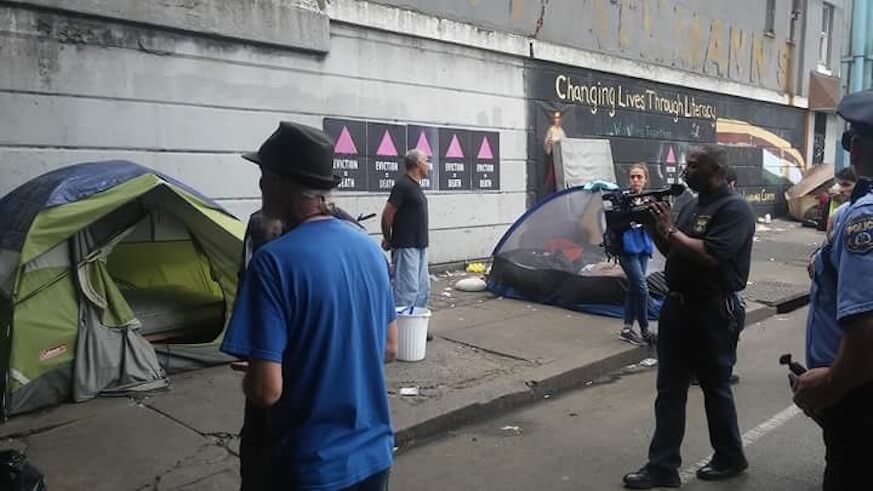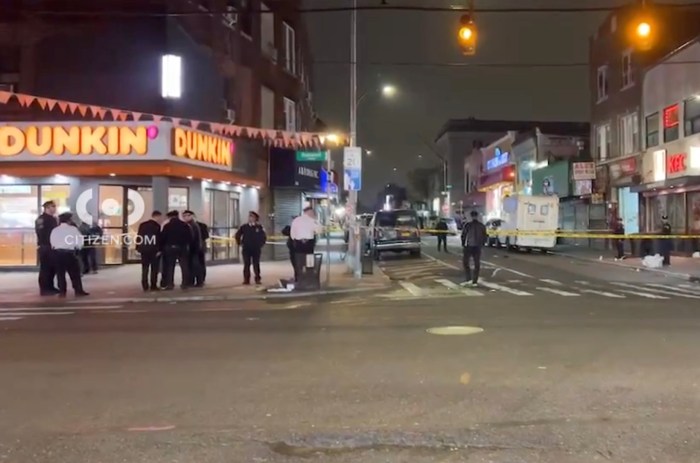Tunnels on Tulip Street and Kensington Avenue where encampments occupied by drug addicts were vacant Wednesday afternoon after city authorities completed a two-day clearing of the tunnels.
The encampments, both in tunnels connecting Lehigh Avenue and Somerset Street in the Riverward, attracted intense attention from the nearby neighborhoods, with some protesting the clearing of the tunnels, while locals cheered the clean-up. Protesters held signs reading “Eviction = death,” “Fund fair housing” and “Treatment not jails” as police officers cleared the tunnels before tents, mattresses and other detritus were thrown into garbage trucks.
“So many lives are going to be lost because of this,” said Roz Pichardo, a neighborhood activist who works with addicts and was with protesters during the cleanup. “At least under the bridge it was all in one area, we knew where to go. They knew to check on their friend, whether they need Narcan. … Now they’re scattered. You’re going to find bodies in between cars, in vacant lots, abandoned houses. The numbers are going to skyrocket in overdoses and the lives we’re not able to save.”
But city officials touted the results of the clean-up, which they said was the conclusion of a 30-day “pilot program” aimed at convincing homeless drug users to accept housing assistance and drug rehabilitation. Early weeks involved daily outreach by service providers and registration of people living in the encampment, as the city freed up 90 beds at local shelters.
“We have never seen a crisis like this before in Philadelphia and doing nothing is not an option,” Philly Managing Director Michael DiBerardinis said in a statement. “We are happy with the preliminary results. We provided respite housing for over 100 people and saw more people enter treatment in the first two weeks of the pilot than in the prior six months; however we have more work to do.”
The city said that over the course of the program, some 120 people accepted services, more than 40 entered drug treatment, and more than two dozen got ID cards. Not having ID cards were identified by many occupants of the encampments as a serious obstacle to getting work, they told city workers.
“This pilot plan shows that many people really do want treatment and housing. When we start with what people need — and want — and are strategic in our efforts, we can make a difference,” said Liz Hersh, director of the city’s Office of Homeless Services, in a statement. “We gave people a chance to get off the street and get the help they need by addressing barriers that are usually a deterrent, such as a lack of transportation and ID’s, as well as providing treatment on demand and low-barrier emergency housing for those who are not ready for treatment, but want to come in. We are very heartened by the results.”
These encampments cropped up after the city joined forces with Conrail to clear an even larger drug camp known as El Campamento, that had formed on abandoned train tracks near Gurney Street, in the Kensington area in August 2017.
“Where else do you think they’re going to go? On somebody’s doorstep,” said Pichardo, who said addiction services should have been offered right at the encampments. “Instead of getting them help you just moved them. That’s not solving the problem, that’s just doing the same s— they did on Gurney Street.”
The city said it will evaluate the results of this encampment clearing before it makes “a determination about how to handle” two more drug user encampments blocks away, at Emerald Street and Frankford Avenue.




























